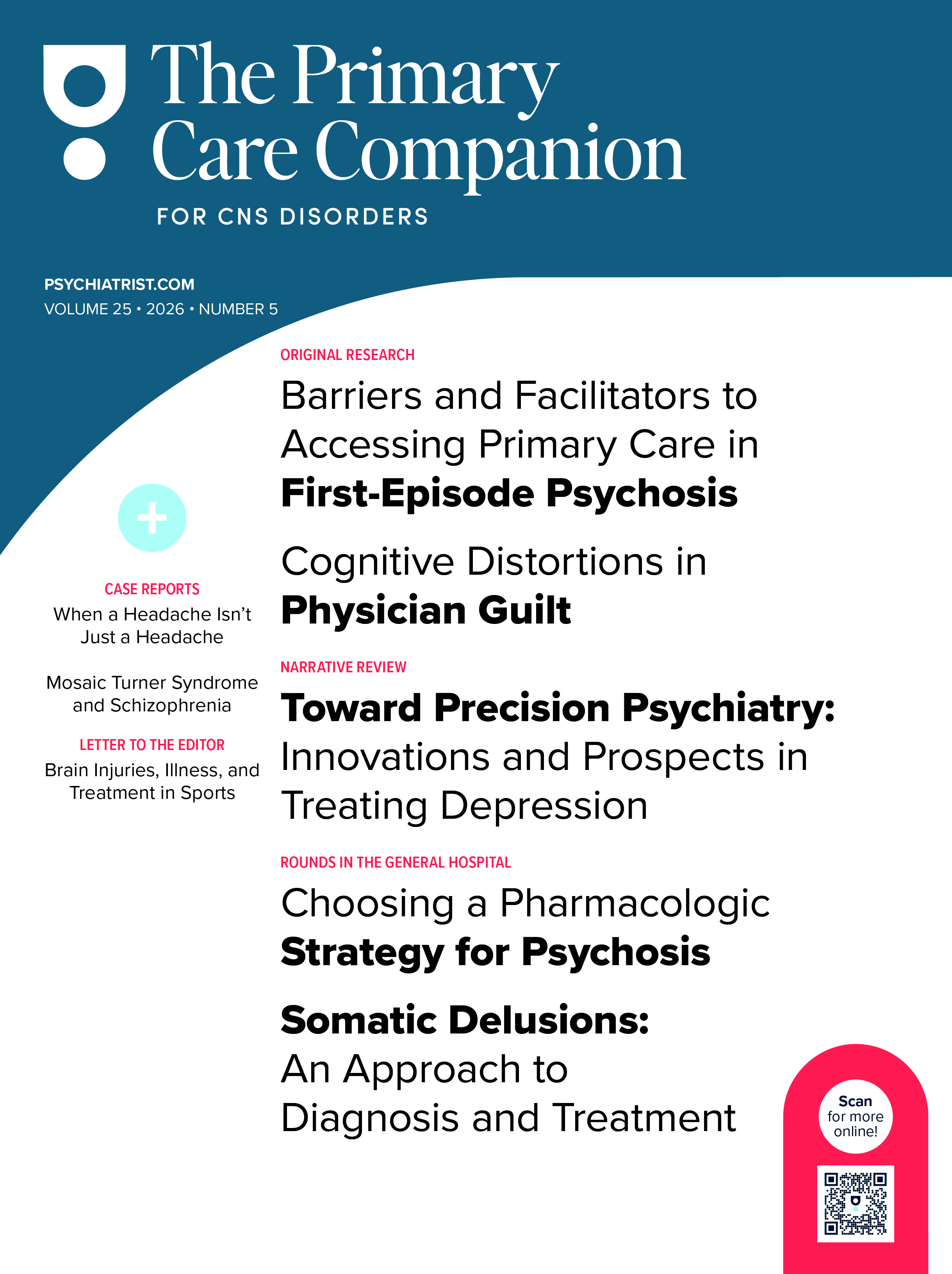Cotard syndrome was named after Dr Jules Cotard, who, in 1880, described the case of a woman who believed herself to be without a brain or entrails.1 Cotard syndrome is rare with limited research of historical accounts and case reports regarding Cotard as a sequela of infectious processes, affective disorders, Parkinson disease, or brain tumors.2,3 Cotard syndrome can present with symptoms ranging from anxious or depressed mood to delusions of damnation, possession, and grandiose ideals of immortality.4 It also consists of delusional beliefs that one is dead or nonexistent, often including nihilistic, self-deprecatory, and bodily delusions.5 As Cotard syndrome can increase a patient’s risk for self-harm, self-starvation, and suicide, it is imperative that early recognition occurs, especially in the emergency department (ED).5
Case Report
A 54-year-old woman with past psychiatric history of major depressive disorder (MDD), anxiety, and anorexia as a young adult presented to the ED on an emergency police hold filed by her family due to not eating and a significant weight loss in the last year. She was noted to be in distress, stating she was “dying and shutting down with no blood.” Per police, she had thrown away her medications and cut herself to show her family that she had no blood left. She had previously presented to the ED on several occasions with an unremarkable medical workup. Given her level of distress, she was escorted to the psychiatric emergency services department. She reported that she had been “rotting from the inside” for around 1 year that included a “foul, bile” smell when brushing her teeth, which she interpreted to mean decay. She distressingly detailed having no blood left and noted that her body did not look normal, gesturing towards herself. She stated that she did not need to eat, and all food tasted like poison. She denied a desire to lose weight. She had a recent psychiatric hospital admission but declined to take prescribed medication, as she did not find it to be beneficial. Given the significant distress caused by her delusions, referrals for inpatient psychiatric hospitalization were made, and antipsychotic medications were started. Given reported multiple medication trials to treat depression, electroconvulsive therapy (ECT) was discussed, which she declined. While waiting in the psychiatric emergency services for inpatient placement, she continued to refuse oral nourishment. She was transferred to the medical floor for intravenous fluids and electrolyte repletion. After 2 days on the medical floor, she requested discharge. Given no objective medical concerns and convincing collateral obtained from family, she was discharged with outpatient psychiatry follow-up.
Discussion
Cotard syndrome can present as a mixed clinical picture. To distinguish symptoms, research has identified further categories such as psychotic depression, Cotard type I, and Cotard type II. Type I symptoms are closer to a delusional disorder and are described as “purer,” whereas type II can present with anxiety, depression, psychotic features, or a mixed picture.6 Within the studied population, depression was found in 89% of subjects, while 69% had anxiety, and conversely, psychotic depression included subjects with melancholia with few nihilistic delusions.6 In our case, the patient’s presentation was within the type II subtype. She had more mood symptoms that contributed to her distress of delusions of death. A broad differential diagnosis still included delusional disorder, schizophrenia, and MDD with psychotic features. For treatment, an antipsychotic was started, given significant distress. However, several treatment options have been shown to be effective, including antipsychotics, mood stabilizers, antidepressants, and ECT.7 The type of treatment chosen can be tailored to presenting symptoms. This case highlights the distinguishing features of Cotard syndrome in the ED to triage patients accordingly and ensure proper escalation of care.
Article Information
Published Online: June 12, 2025. https://doi.org/10.4088/PCC.25cr03921
© 2025 Physicians Postgraduate Press, Inc. Prim Care Companion CNS Disord 2025;27(3):25cr03921
Submitted: January 16, 2025; accepted March 10, 2025.
To Cite: Nava Frenier MA, Sharma A, Benton J. Recognizing Cotard syndrome in the emergency department setting. Prim Care Companion CNS Disord 2025;27(3):25cr03921.
Author Affiliations: Department of Psychiatry, University of Nebraska Medical Center, Omaha, Nebraska (all authors).
Corresponding Author: Monica A. Nava Frenier, MD, Department of Psychiatry, University of Nebraska Medical Center, 985575, Omaha, Nebraska 68198-5575 ([email protected]).
Relevant Financial Relationships: None.
Funding/Support: None.
Additional Information: Information has been de-identified to protect patient confidentiality.
References (7)

- Berrios GE, Luque R. Cotard’s delusion or syndrome?: a conceptual history. Compr Psychiatry. 1995;36(3):218–223. CrossRef
- Ramirez-Bermudez J, Aguilar-Venegas LC, Crail-Melendez D, et al. Cotard syndrome in neurological and psychiatric patients. J Neuropsychiatry Clin Neurosci. 2010;22(4):409–416. CrossRef
- Stewart AL, Robinson DM. Cotard’s syndrome as a neuropsychiatric sequela of COVID-19. J Acad Consult Liaison Psychiatry. 2022;63(2):182–183. CrossRef
- Moschopoulos NP, Kaprinis S, Nimatoudis J. [Cotard’s syndrome: case report and a brief review of literature]. Psychiatriki. 2016;27(4):296–302.
- Dieguez S. Cotard syndrome. Front Neurol Neurosci. 2018;42:23–34.
- Berrios GE, Luque R. Cotard’s syndrome: analysis of 100 cases. Acta Psychiatr Scand. 1995;91(3):185–188. CrossRef
- Solimine S, Chan S, Morihara SK. Cotard syndrome: “I’m dead, so why do I need to eat? Prim Care Companion CNS Disord. 2016;18(2):10.4088/PCC.15l01862.
Please sign in or purchase this PDF for $40.




